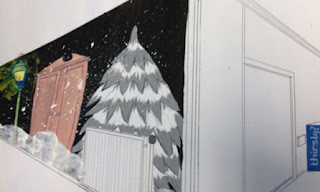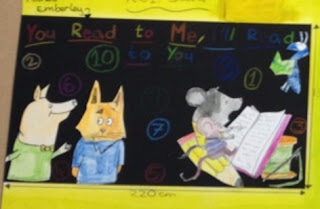One and Two point Perspective Drawing.
Key Terms:
- Perspective; One & Two Point
- Observation
- Horizon Line/ Eye Line
- Floor/ Ground Line
- Vanishing Point
Equipment:
- T-Square
- Pencil
- 45 Degree Set Square
- A2 Drawing Board
- Masking Tape
- Rubber & Ruler (30cm & 1m)
One Point Perspective Drawing
1) First you need to get your board set up ready to draw. To do this you get your board in a landscape format and use masking tape to keep it in place. The best places to place the masking tape are at the top, on the left, on the right and also at the bottom. This picture below illustrates where to put the making tape.
2) The next step is to find your vanishing point. To do this you will need to get your meter ruler and put one end in the top left corner and the other end in the bottom right corner. You can either use your pencil to mark the line from corner to corner or just mark a line near the centre. Once you have done this; do the same with your ruler but put it from the top right corner to the bottom left corner.
3) Now you need to find the horizon line. To do this you have to keep your vanishing point by using your rubber take away the diagonal lines but keep your vanishing point. Next take your T-square and but the top of the T to the left side of your board horizontally. Now you can use your pencil to draw the horizon line like this shown below.
4) Now you can add in your back wall. This is done by you drawing a box using the T-Square to assist you in drawing the horizontal lines and the T-Square and the 45 degree set square for the vertical lines. You can make this wall as big as you need it but below is a quick example of a finished back wall.
5) After step 4 you are ready to add in the ceiling lines and the ground lines. This is accomplished by using your 30 cm or your 1 meter ruler. You need to draw a line from a corner of the back wall you have already drawn, to the corner of your A2 paper. You will need to repeat this for each corner of the back wall. Once complete you should have something like this below.
6) Finally you can add in extra sections of the room you are doing. For my example I am going to add another wall coming out from the back wall. To do this I used the T-Square for the horizontal lines and the vertical lines as well as the 45 degree set square. I first drew the square in the for ground and then joined the left corners to the ceiling line to make the impression of the second wall coming out.
Two Point Perspective Drawing
1) To begin this two point perspective drawing you will need to follow step 1 to 3 from the one point perspective drawing guide.
2) Next you have to plan where the corner of your wall is going to be. Once you have an idea you need to get your T-Square and your 45 degree set square to draw the line of your wall corner. Like the one below.
3) Now from your horizon line you have to mark out your 2 vanishing points like the black dots on the image below.
4) Now anything on the right of your wall corner from the wall corner will join up to the right vanishing point. Like is shown in the image below.
5) everything on the left of the wall corner from the wall corner will join up to the left vanishing point. Again as shown in the image below.
6) now you can add other lines to your image to make it like the room you are drawing. All the horizontal lines are always horizontal, all the vertical lines are always vertical, all the diagonal lines pointing towards the right should always be in-line with the vanishing point on the right, all the diagonal lines pointing towards the left should always be in-line with the vanishing point on the left. All of this is displayed below.

























